If you rely on shipping LTL to keep products moving to your customers, staying informed about the impending changes to the National Motor Freight Classification (NMFC) system in 2025 is critical to optimizing your LTL rates and mitigating excess costs.
The upcoming modifications to the NMFC by the National Motor Freight Traffic Association (NMFTA) underscore the importance of strategizing effectively to navigate the evolving LTL landscape, especially in ensuring the accurate use of LTL freight class to avoid unexpected surcharges or higher shipping expenses. With a focus on reducing risks associated with incorrect NMFC codes, shippers should proactively review and understand these changes to streamline their LTL shipping processes and enhance cost-efficiency.
Why is the NMFTA making so many changes to the NMFC system in 2025?
The NMFTA has been making changes to freight classes over the years. The main catalyst behind this is so that freight is classified properly, but also so that there is increased accuracy in terms of handling unit dimensions and weight. By having the correct information on a shipment, shippers will reduce any surprises when shipping LTL.
- Standardized Density Scale: The introduction of a unified density scale for LTL shipments will simplify assessment and pricing, streamlining the handling process.
- Unique Identifiers: Freight with distinct handling, stowability or liability requirements will now feature unique identifiers for more precise categorization and handling.
- Condensed Commodity Listings: The modernization and consolidation of commodity listings will bring forth a more organized and user-friendly system.
- Fairer Pricing: An equitable pricing structure will be implemented, with heavier freight being slotted into lower density classes to promote fairness and accuracy.
- Enhanced Visibility: Stakeholders – be it shippers, carriers or 3PLs – can anticipate a significant boost in visibility and transparency throughout the shipping process.
The phases leading up to the 2025 NMFC changes, kickstarted by Docket 2025-1, invite carriers, shippers and freight brokerages to actively engage through listening sessions and continuous information absorption to adapt seamlessly to these forthcoming adjustments.
What is the Relationship between NMFC Codes and LTL Freight Class?
- Understanding the NMFC System
The NMFC codes act as a cornerstone in classifying freight based on factors such as density, stowability, handling and liability, assigning commodities to one of the 18 freight classes (ranging from 50 to 500). Lower LTL freight class numbers usually indicate more attractive freight to a carrier. - The Interplay of NMFC Codes and LTL Freight Class
Freight class essentially represents a category assigned to items based on their shipping characteristics, with each commodity linked to a specific LTL freight class through the NMFC system. This relationship ensures accurate pricing and handling guidelines for shipments. - Decoding Shipping Density as Defined by NMFTA
Shipping density, a crucial parameter in determining an item’s NMFC code, is calculated by dividing the weight of an item by its volume in cubic feet. Items with higher density typically fall into lower freight classes, influencing pricing and handling considerations during transit.
Want to mitigate surprises when shipping LTL? Know Your NMFCs.
When you do not use the correct NMFC codes when shipping LTL, there are several risks that you may encounter:
- Reclassification: If you do not accurately classify your products using the correct NMFC codes, carriers may reclassify them. This can lead to unexpected surcharges or higher shipping costs, as carriers may assign a higher LTL freight class based on their judgment. Knowing your NMFC codes helps you avoid these reclassification issues.
- Inaccurate Rates: Using the wrong NMFC codes can result in inaccurate freight rates. If your products are classified in a higher LTL freight class than they should be, you may end up paying more for shipping than necessary. Conversely, if your products are classified too low, carriers may charge you additional fees for the discrepancy.
- Mishandling of Shipments: Improper classification of goods can lead to mishandling during transit. If carriers are not aware of the correct classification of your products, they may not handle them with the care required. This can result in damaged goods, delays, and customer dissatisfaction. Knowing your NMFC codes ensures that carriers understand the specific handling requirements of your shipments.
How can you be sure you are using the correct NMFC code if you are shipping LTL?
Empowered with several resources and strategic approaches, LTL shippers can effectively determine their correct NMFC codes by utilizing:
- NMFC Classification Tools: Leveraging tools like ClassIT or the NMFC directory to accurately categorize commodities.
- Consulting with Experts: Seeking guidance from carriers or managed transportation providers well-versed in LTL shipping – like Transportation Insight – for expert advice.
- Manufacturer Collaboration: Collaborating with manufacturers to obtain accurate NMFC codes for specific products to ensure precise classification.
Shipping LTL Backed by Industry Experts with Your Success in Mind
Transportation Insight, with decades of experience assisting its clients in navigating the complexities of LTL shipping, offers unparalleled expertise to help you optimize your shipping strategies considering the NMFC changes in 2025. Reach out to our experts today for guidance and support in ensuring accurate classification of your freight and mitigating excess costs.




